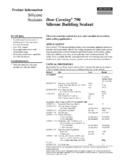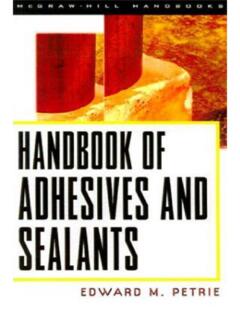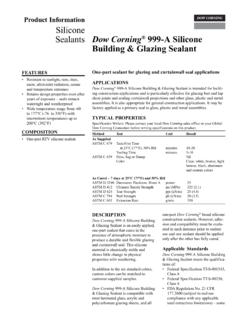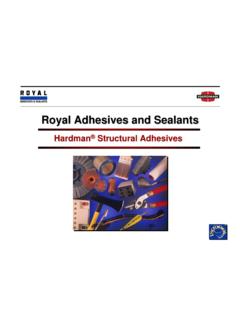Transcription of Two Part Polysulfide Joint Sealants - DP Products
1 TECHNICAL DATA SHEET. HORNFLEX NS / HORNFLEX SL. Two part Polysulfide Joint Sealants 1. DESCRIPTION: HORNFLEX Sealants are two part , elas- removed from metal surfaces with methyl ethyl ketone or MARCH 2002. TAMMS INDUSTRIES. 07920. tomeric, caulking and sealing compounds. HORNFLEX cures xylol. Cure new concrete or masonry surfaces for 28 days. Do THERMAL AND MOISTURE PROTECTION. at normal temperatures to a tough elastomeric seal which will not apply HORNFLEX if the temperature of the sealant , air, or adhere tenaciously to masonry, metal and wood. HORNFLEX substrate is below 40 F. Priming is not normally required with will withstand repeated expansion and contraction and remain common building materials.
2 A primer may be required for resilient through daily and seasonal cyclic changes in temper- optimum adhesion in demanding environments, continuous ature. HORNFLEX has excellent chemical, solvent, and water immersion for example, or for certain substrates. In these cases resistance and will withstand Joint movement of up to 25%. HORNFLEX PRIMER should be used and the sealant must be (Replaces 1/01). Sealants AND CAULKING. applied within 8 hours after priming. A field trial is recom- 2. USES: HORNFLEX Sealants are used for glazing, caulking, mended to determine actual adhesion with and without a and sealing joints between similar or dissimilar materials.
3 Primer. They are particularly effective in sealing joints subject to struc- tural movement due to expansion and contraction resulting 6. Joint DESIGN: The minimum width of the Joint should be from temperature changes. HORNFLEX Sealants are available 4 times the anticipated movement but not less than 1/4 inch. in two types. Maximum recommended width is inch. The depth of the HORNFLEX NS is a non sag gun grade sealant designed for Joint should be no more than one-half the width without use in vertical and non traffic bearing horizontal joints subject exceeding the minimum/maximum limits.
4 To expansion resulting from temperature changes. HORN- In joints up to 1/2 inch wide, the sealant depth should be equal FLEX NS is used for all normal construction joints such as to the Joint width. In joints from 1/2 inch to inch wide, panel and curtain wall construction, copings, masonry joints, sealant depth should be 1/2 inch. For joints over inch wide, bridge abutments and building joints. HORNFLEX NS is for- sealant depth should be 1/2 of the width. In joints deeper than mulated for use in joints subject to long term contact with 1/2 inch, a flexible, non asphaltic or non oil impregnated back- water and may be used in water reservoirs, dams and founda- ing material should be used to fill the lower part of the Joint tion joints.
5 Cavity. For traffic bearing areas, a round rod of synthetic rub- HORNFLEX SL is a flowable, self leveling, traffic grade ber of the same Shore A as HORNFLEX SL (or harder) is rec- sealant designed for horizontal joints in patios, plazas, floors, ommended. The backing rod should be round to minimize the sidewalks, roadways and other areas exposed to pedestrian or stress on the Joint sealant . vehicular traffic. The sealant should not adhere to the bottom of the Joint or the backing material. A strip of polyethylene film may be installed TYPICAL PROPERTIES: as a bond breaker between the filler or the bottom of the Joint Specific Gravity, mixed and the sealant .
6 % Solids 100. % Joint Movement 25 7. MIXING INSTRUCTIONS: Thorough mixing of the com- Hardness, Shore A 25-30 ponents is essential for maximum performance of HORN- Pot Life Temperature Dependent approx. 2 hrs FLEX. Remove the activator ( part B) from the base material Tack Free 12-24 hrs ( part A) container. Also remove the polyethylene sheet or tray. Mix part A with a slow speed 1/2 inch drill (250-300 rpm) with Sealants AND CAULKING. THERMAL AND MOISTURE PROTECTION. % Elongation 500-550. a Jiffy mixing paddle. Then add part B to part A and mix for Tensile Strength, psi 150-200. 3-4 minutes until the material is completely blended with a 100% Modulus, psi 50 uniform color.
7 While mixing, periodically scrape down the 200% Modulus, psi 80 sides of the container and mixing paddle. Caution. Do not mix base and activator components from one (Replaces 1/01). 3. COLORS: HORNFLEX is gray/brown in color. shipment with components from another. 4. COMPLIANCE: The HORNFLEX Sealants exceed the 8. APPLICATION TECHNIQUES: HORNFLEX Sealants requirements of ASTM C920. Hornflex NS complies with allow 1-2 hours of working time under normal conditions. Do NSF Standard 61 requirements. not mix more than can be applied in this period. HORNFLEX. TAMMS INDUSTRIES. NS can be applied with standard caulking equipment.
8 Always 5. SURFACE PREPARATION: Surface of the Joint must be fill the Joint from the bottom up or from the inside out to avoid clean, sound, and dry. Contaminants such as previously entrapping air. The gun nozzle should be the largest size which MARCH 2002. applied Sealants , form release agents, grease, oil, etc. must be can be inserted to the bottom of the Joint . Tooling is recom- removed by scarifying, wire brushing, or sanding. All traces of mended immediately after application to ensure full contact asphalt or other bituminous materials must be removed. Dust with the Joint surfaces.
9 Dry tooling is preferred. HORNFLEX. 07920. should be blown out of the Joint with oil free, moisture free SL may be poured into the Joint . It pours readily and is self lev- compressed air. Protective coatings of lacquer or oil must be eling. 9. COVERAGE: HORNFLEX coverage rates are approximate and for estimating purposes only. Linear Feet Joint Width(in.). _____ Joint Depth(in). _____ per Gallon _____. 1/4 1/4 308. 1/4 3/8 136. 3/8 3/8 102. 1/2 3/8 068. 1/2 1/2 077. 5/8 1/2 061. 3/4 1/2 051. 7/8 1/2 044. 1 1/2 038. INSTRUCTIONS: Clean tools and equipment immediately after application with xylene, toluene or Aromatic 100.
10 Clean up spills and drips while still wet with the same sol- vents. 11. PACKAGING: gallon units. Storage: 50 -90 F. Protect from moisture. Shelf Life: 12 months in proper storage. SAFETY PRECAUTIONS: Indus- trial Use Only. Provide adequate ventilation. Can be irritating to eyes and skin. Wear goggles and protective clothing. In case of eye contact, flood the eyes repeatedly with water and call a physician immediately. DO NOT RUB EYES. In case of skin contact, wash immediately and thoroughly with soap and water. For respiratory problems, remove person to fresh air and call a physician.







